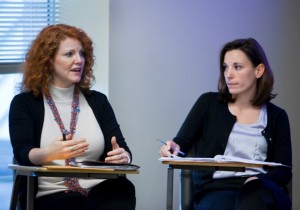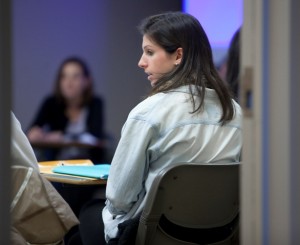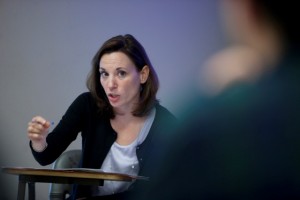
Professors Jennifer Kelly, left, and Lisa Gabel teach in Oechsle Hall.
ABC’s Primetime recently profiled Congresswoman Gabrielle Giffords, who was critically injured by a gunshot wound to the head in January. In discussing her recovery from her traumatic brain injury, the news program addressed music’s role in Giffords’ recovery of language.
The congresswoman’s experience shows the potential for music therapy to be a powerful tool in treating neurological disorders, a concept that Jennifer Kelly, assistant professor of music, finds particularly intriguing.
“I am fascinated by the new developments in brain research and the correlation to musical patterns, creativity, memory, and kinesthetic connection. The burgeoning field of music therapy directly results from this developing brain/music research,” Kelly says.
She and Lisa Gabel, assistant professor of psychology, are team teaching a new interdisciplinary course that highlights these connections. “Music and the Brain: the Neuroscience of Music” explores topics such as how the brain processes music, how music affects the brain, and how music can be used as a therapy for neurological disorders including Parkinson’s syndrome, Tourette’s syndrome, and stroke.

Carly Ennis '12 listens during class.
“In my personal experience, I have found ways to apply psychology to music and vice versa, but I wanted to learn more about the science behind these connections,” says Kara Enz ’13 (Milford, N.J.), a double major in psychology and music. “Going into the course, I was interested in learning about overlaps in both research and application of neuroscience and music. I was curious about how the brain interprets music but also how music could be used as a therapy,” Enz says.
Gabel and Kelly keep the students engaged with hands-on group activities to reinforce concepts. During one class session, they might take part in an improvisation exercise, using not only percussion instruments, but their bodies and the room itself—such as the floor, the blinds, and the chalkboard–to create music. In another, they might listen to a student presentation about how the brain responds to unexpected notes in a piece of music.
Kelly and Gabel also lead an in-class research experiment to study the influence of Mozart on spatial-temporal reasoning, the so-called “Mozart Effect.” Students then write research papers documenting the process and results.
Students are required to attend a concert at the Williams Center, and keep journals in which they reflect on an idea or respond to a question posed in class.

Professor Lisa Gabel
The final project for the class is a proposal presentation, done in pairs, for which students have to do background research and design a study to examine a topic of their choice within neuroscience and music.
Gabel and Kelly make a point of including very recent research in the class. They frequently discuss studies that came out only a few months, or even a few weeks, earlier.
“There are two things about the course that have really stood out to me: its interdisciplinary nature and how cutting-edge the field is,” says Ross Moretti ’12 (Freehold, N.J.), a chemistry major.
Neuorscience major Carly Ennis ’12 (South Salem, N.Y.) says she found it particularly interesting that music has an effect not only on mood and emotion, but on the actual anatomical structure of the brain.
“Musicians have been found to have a larger corpus callosum than non-musicians, which is the fibrous structure in the brain that allows the communication between the two hemispheres. This evidence suggests that playing and listening to music involves both sides of the brain, which is very intriguing,” Ennis says.
Kelly says that learning more about the science side of music has informed her teaching in other courses.
“As a teacher of ensemble, I explore kinesthetic connection, patterns associated with memory, and musical expression. As I develop a more sophisticated understanding of how and why those connections occur in the brain, I bring that understanding into my classroom with newly developed exercises and means of learning,” Kelly says.
Gabel says that the interdisciplinary nature of the course echoes what is happening in the research community.
“For at least the last decade anecdotal evidence has demonstrated that music training and therapy have had a positive influence on behavior and learning and memory, but it has only been more recently that scientists have begun to examine the mechanisms underlying this phenomenon. From my perspective, the most powerful way to begin to understand this process is for researchers within these two disciplines to work together toward the common goal of understanding the interconnection between the humanities and natural sciences,” Gabel says.



4 Comments
What I wouldn’t give to be in this course!!
Having worked with both of these professors separately, I can only imagine the amount of passion and energy that they put into this course.
In addition, with the demand of modern thinkers and liberal arts colleges to encourage interdisciplinary knowledge and work and staying on the cutting edge of research, this course raises the bar to new heights. These are skills and abilities that are translatable no matter what a student wants to do.
Thank you both for your efforts to bring Lafayette to a new level of excellence. Keep it up and I look forward to more things like this in the future!
And if you ever consider teaching something similar for alumni, let me know! I will be there in a jiffy!
Fantastic!
Keep up the good work 🙂
Amy
It doesn’t take a degree or congressperson to convince me that songs can help heal the brain. Just look around. Practically everybody you see is wearing headphones or has their car stereo playing music. Even elevators, department stores, doctors offices, you name it has music playing. Us older folks used to listen to more music as kids. Did we forget? It was and is our way of excaping (healing) the everyday drain of life.
Maybe different styles of music have different vibrations in connection to positive or negative results in each individual. I’m sure not “one fits all” is the way to go here. For some it may be rock and roll, others r&b, and others classical, and so forth.
Music is one of the connections to the heart and soul, however the brain processes it. And the songs that ‘heal my brain’ are rock and roll, for sure!
To each his and her own.
Peace
It’s been noted by scholars and researchers that music helps us in so many different ways to improve our lives, our thinking and our decision making.
Some experts surmise that if music has this profound effect on older kids, babies and even fetuses may benefit from it the same way. Others say newborns can recognize music their parents played for them when they were in the womb and even perk up or fall asleep when they hear a familiar song.
So I say, let’s go for it…
Comments are closed.